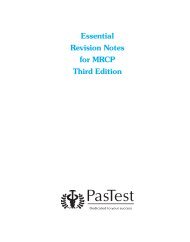EMQs for Medical Students - PasTest
EMQs for Medical Students - PasTest
EMQs for Medical Students - PasTest
You also want an ePaper? Increase the reach of your titles
YUMPU automatically turns print PDFs into web optimized ePapers that Google loves.
E M Q s F O R M E D I C A L S T U D E N T S – V O L U M E 2<br />
as Salmonella, Campylobacter and Shigella, but the predominant symptoms in such<br />
cases are invariably lower abdominal pain, diarrhoea or dysentery.<br />
3. G – Gastric outflow obstruction<br />
Gastric outflow obstruction has been caused in this case by neonatal pyloric stenosis.<br />
This patient is the right age <strong>for</strong> this (3–6 weeks), and has the characteristic history of<br />
this disorder (projectile vomiting after each meal). The finding of the so-called ‘pyloric<br />
tumour’ caused by pyloric contraction during feeding provides further confirmation.<br />
The disorder is due to hypertrophy of circular muscle of the pyloric region of the<br />
stomach. The baby is classically well and seeking more feed after vomiting but dehydration<br />
and severe electrolyte disturbances (especially acid-base disorder and<br />
hypokalaemia) will eventually arise. The condition is treated surgically with a<br />
Ramstedt pyloromyotomy.<br />
4. I – Small-intestinal obstruction<br />
This is the classic clinical description of a patient presenting with small-bowel obstruction<br />
– colicky, central abdominal pain, distension, nausea and vomiting (eventually bilestained).<br />
In this woman’s case, the cause is probably adhesions secondary to her previous<br />
intra-abdominal inflammation/sepsis. In contrast, gastric outflow obstruction does not<br />
cause bilious vomiting and large-intestinal obstruction is characterised by lower<br />
abdominal colic and constipation, with vomiting (faeculant) being a later feature.<br />
5. A – Acute abdomen<br />
This is a case of acute abdomen, probably appendicitis. Acute inflammation affecting<br />
any part of the gastrointestinal tract will lead to a localised ileus (or generalised ileus in<br />
the case of generalised peritonitis) and to nausea and vomiting. Common examples<br />
include pancreatitis, cholecystitis and appendicitis.<br />
NB: A complete overview of all the causes of vomiting (not possible in one EMQ)<br />
should include the following:<br />
• Central – intracranial, labyrinthine<br />
• Metabolic and endocrine – uraemia, pregnancy, diabetes<br />
• Iatrogenic – cancer chemotherapy, digoxin, opiates<br />
• Obstructive – any level (see above)<br />
• Mucosal – appendicitis, gastritis, cholecystitis.<br />
3. HAEMATEMESIS<br />
1. B – Gastric erosions<br />
The most likely cause is gastric erosions. Stress ulceration leading to erosions of the<br />
stomach (and to some extent also of the duodenum) is a complication of significant<br />
burns (Curling’s ulcer), as well as other traumatic injuries, systemic sepsis, intracranial<br />
lesions (Cushing’s ulcer) and organ failure (eg uraemia). The risk of bleeding can be<br />
reduced by giving a mucosa-protecting agent such as sucralfate or prophylactic<br />
antacid treatments (eg ranitidine). These agents are there<strong>for</strong>e commonly used in an<br />
intensive-care environment.<br />
162

















